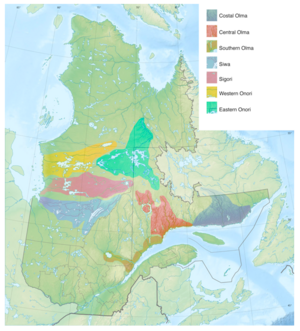Proto-Alopian: Difference between revisions
No edit summary |
No edit summary |
||
| Line 13: | Line 13: | ||
| creator = Étienne L. Poisson | | creator = Étienne L. Poisson | ||
| region = Western Canada | | region = Western Canada | ||
| familycolor = Alopian | | familycolor = Alopian | ||
| protoname = [[Proto-Alopian]] | | protoname = [[Proto-Alopian]] | ||
| child1 = Forest Alopian | | child1 = Forest Alopian | ||
** Siwa | ** Siwa | ||
** Sigori | ** Sigori | ||
| child2 = Tundra Alopian | | child2 = Tundra Alopian | ||
** Eastern Onori | ** Eastern Onori | ||
** Western Onori | ** Western Onori | ||
| child3 = Coastal Alopian | | child3 = Coastal Alopian | ||
** Coastal Olma | ** Coastal Olma | ||
** Central Olma | ** Central Olma | ||
** Southern Olma | ** Southern Olma | ||
| map = Alopian.png | | map = Alopian.png | ||
| mapcaption = {{#tag: center|Distribution of Alopian languages}} | | mapcaption = {{#tag: center|Distribution of Alopian languages}} | ||
| Line 44: | Line 42: | ||
==From Proto-Alopian to Siwa== | ==From Proto-Alopian to Siwa== | ||
Siwa is by far the most documented Alopian language, part of the Forest Alopian branch, and it is the language of around 30 000–60 000 speakers. The following list gathers most sound changes that Proto-Alopian underwent to become Siwa. | Siwa is by far the most documented Alopian language, part of the Forest Alopian branch, and it is the language of around 30 000–60 000 speakers. The following list gathers most sound changes that Proto-Alopian underwent to become Siwa. ''Not in chronological order''. | ||
* '''''*b''''' became ''m'' intervocalically before long front vowels ''*ē'', ''*ī''. Before ''*o'', ''*u'', it remained as ''b'' or changed to ''m'' and ''w''. | |||
<center><code>*b > {∅,m} / V_{ē,ī}</code> <code>*b > {b,m,w} / V_{o,u}</code></center> | |||
* '''''*w''''' usually became ''v'' before stressed front vowels, although it sometimes changed to ''m'' before ''*ē'', ''*ī'' like ''*b''. It disappeared between identical vowels. | |||
<center><code>*w > v / _V[+stress +front]</code> <code>*w > m / _{ē,ī}</code> <code>*w > ∅ \ V₁_V₁</code></center> | |||
* '''''*d''''' | |||
</div> | </div> | ||
[[Category:Languages]][[Category:A priori]] | [[Category:Languages]][[Category:A priori]] | ||
Revision as of 18:42, 14 April 2022
| Proto-Alopian | |
|---|---|
| Proto-Siwa | |
| Created by | Étienne L. Poisson |
| Reconstruction of | Alopian |
| Region | Western Canada |
| Era | 2000 BCE |
| Alopian | |
|---|---|
| Created by | Étienne L. Poisson |
| Geographic distribution | Western Canada |
| Linguistic classification | Alopian
|
| Proto-language | Proto-Alopian |
| Subdivisions |
|
 | |
Proto-Alopian is the reconstructed ancestor of the Alopian language family. Little is known about its inventory or possible attestations other than the historical sound changes. It is believed that the Alopian people migrated from Europe around 3000 BCE, in the Holocene epoch.
The two main theories of how this migration took place are either by foot over the frozen oceans of the Last Glacial Period (known as “Early Settlement”) or by boat through the steadily-rising Atlantic Ocean (“Late Settlement”).
After thousands of years of apparent nomadism, the Alopian people settled in present-day Quebec, where the common language began to split into different dialects that formed the Alopian languages.
While most words are native (a priori), Proto-Alopian features roots from Uralic and Algonquian languages as a product of their migration.
Etymology
The word “Alopian” that gives name to the language family comes from the Lua error in Module:languages at line 576: attempt to index local 'first_sc' (a nil value)., meaning “fox”, a strong cultural item for the Alopian people.
From Proto-Alopian to Siwa
Siwa is by far the most documented Alopian language, part of the Forest Alopian branch, and it is the language of around 30 000–60 000 speakers. The following list gathers most sound changes that Proto-Alopian underwent to become Siwa. Not in chronological order.
- *b became m intervocalically before long front vowels *ē, *ī. Before *o, *u, it remained as b or changed to m and w.
*b > {∅,m} / V_{ē,ī} *b > {b,m,w} / V_{o,u}- *w usually became v before stressed front vowels, although it sometimes changed to m before *ē, *ī like *b. It disappeared between identical vowels.
*w > v / _V[+stress +front] *w > m / _{ē,ī} *w > ∅ \ V₁_V₁- *d